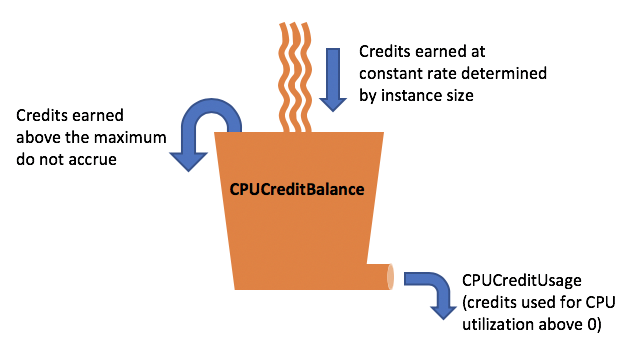

CPU credits and baseline utilization
source link: https://docs.aws.amazon.com/AWSEC2/latest/UserGuide/burstable-credits-baseline-concepts.html
Go to the source link to view the article. You can view the picture content, updated content and better typesetting reading experience. If the link is broken, please click the button below to view the snapshot at that time.

CPU credits and baseline utilization for burstable performance instances
Traditional Amazon EC2 instance types provide fixed CPU utilization, while burstable performance instances provide a baseline level of CPU utilization with the ability to burst CPU utilization above the baseline level. The baseline utilization and ability to burst are governed by CPU credits.
The CPU credits used depends on CPU utilization. The following scenarios all use one CPU credit:
-
One vCPU at 100% utilization for one minute
-
One vCPU at 50% utilization for two minutes
-
Two vCPUs at 25% utilization for two minutes
Earn CPU credits
Each burstable performance instance continuously earns (at a millisecond-level resolution) a set rate of CPU credits per hour, depending on the instance size. The accounting process for whether credits are accrued or spent also happens at a millisecond-level resolution, so you don't have to worry about overspending CPU credits; a short burst of CPU uses a small fraction of a CPU credit.
If a burstable performance instance uses fewer CPU resources than is required for baseline utilization (such as when it is idle), the unspent CPU credits are accrued in the CPU credit balance. If a burstable performance instance needs to burst above the baseline utilization level, it spends the accrued credits. The more credits that a burstable performance instance has accrued, the more time it can burst beyond its baseline when more CPU utilization is needed.
The following table lists the burstable performance instance types, the rate at which CPU credits are earned per hour, the maximum number of earned CPU credits that an instance can accrue, the number of vCPUs per instance, and the baseline utilization as a percentage of a full core (using a single vCPU).
Instance type
CPU credits earned per hour
Maximum earned credits that can be accrued*
vCPUs
Baseline utilization per vCPU
T2
t2.nano
t2.micro
t2.small
t2.medium
20%**
t2.large
30%**
t2.xlarge
22.5%**
t2.2xlarge
1958.4
17%**
T3
t3.nano
t3.micro
10%**
t3.small
20%**
t3.medium
20%**
t3.large
30%**
t3.xlarge
40%**
t3.2xlarge
40%**
T3a
t3a.nano
t3a.micro
10%**
t3a.small
20%**
t3a.medium
20%**
t3a.large
30%**
t3a.xlarge
40%**
t3a.2xlarge
40%**
T4g
t4g.nano
t4g.micro
10%**
t4g.small
20%**
t4g.medium
20%**
t4g.large
30%**
t4g.xlarge
40%**
t4g.2xlarge
40%**
* The number of credits that can be accrued is equivalent to the number of credits that can be earned in a 24-hour period.
** The percentage baseline utilization in the table is per vCPU. In
CloudWatch, CPU utilization is shown per vCPU. For example, the CPU utilization
for a t3.large instance operating at the baseline level is
shown as 30% in CloudWatch CPU metrics. For information about how to calculate
the baseline utilization, see Baseline utilization.
CPU credit earn rate
The number of CPU credits earned per hour is determined by the instance size. For
example, a t3.nano earns six credits per hour, while a
t3.small earns 24 credits per hour. The preceding table lists the
credit earn rate for all instances.
CPU credit accrual limit
While earned credits never expire on a running instance, there is a limit to the number of earned credits that an instance can accrue. The limit is determined by the CPU credit balance limit. After the limit is reached, any new credits that are earned are discarded, as indicated by the following image. The full bucket indicates the CPU credit balance limit, and the spillover indicates the newly earned credits that exceed the limit.

The CPU credit balance limit differs for each instance size. For example, a
t3.micro instance can accrue a maximum of 288 earned CPU credits in the
CPU credit balance. The preceding table lists the maximum number of earned credits
that
each instance can accrue.
T2 Standard instances also earn launch credits. Launch credits do not count towards the CPU credit balance limit. If a T2 instance has not spent its launch credits, and remains idle over a 24-hour period while accruing earned credits, its CPU credit balance appears as over the limit. For more information, see Launch credits.
T3 and T4g instances do not earn launch credits.
These instances launch as unlimited by default, and therefore can burst
immediately upon start without any launch credits.
Accrued CPU credits life span
CPU credits on a running instance do not expire.
For T2, the CPU credit balance does not persist between instance stops and starts. If you stop a T2 instance, the instance loses all its accrued credits.
For T3 and T4g, the CPU credit balance persists for seven days after an instance stops and the credits are lost thereafter. If you start the instance within seven days, no credits are lost.
For more information, see CPUCreditBalance in the CloudWatch metrics table.
Baseline utilization
The baseline utilization is the level at which the CPU can be utilized for a net credit balance of zero, when the number of CPU credits being earned matches the number of CPU credits being used. Baseline utilization is also known as the baseline.
Baseline utilization is expressed as a percentage of vCPU utilization, which is calculated as follows:
(number of credits earned/number of vCPUs)/60 minutes = % baseline
utilization
For example, a t3.nano instance, with 2 vCPUs, earns 6 credits per hour,
resulting in a baseline utilization of 5% , which is calculated as follows:
(6 credits earned/2 vCPUs)/60 minutes = 5% baseline utilization
A t3.xlarge instance, with 4 vCPUs, earns 96 credits per hour, resulting
in a baseline utilization of 40% ((96/4)/60).
Recommend
About Joyk
Aggregate valuable and interesting links.
Joyk means Joy of geeK